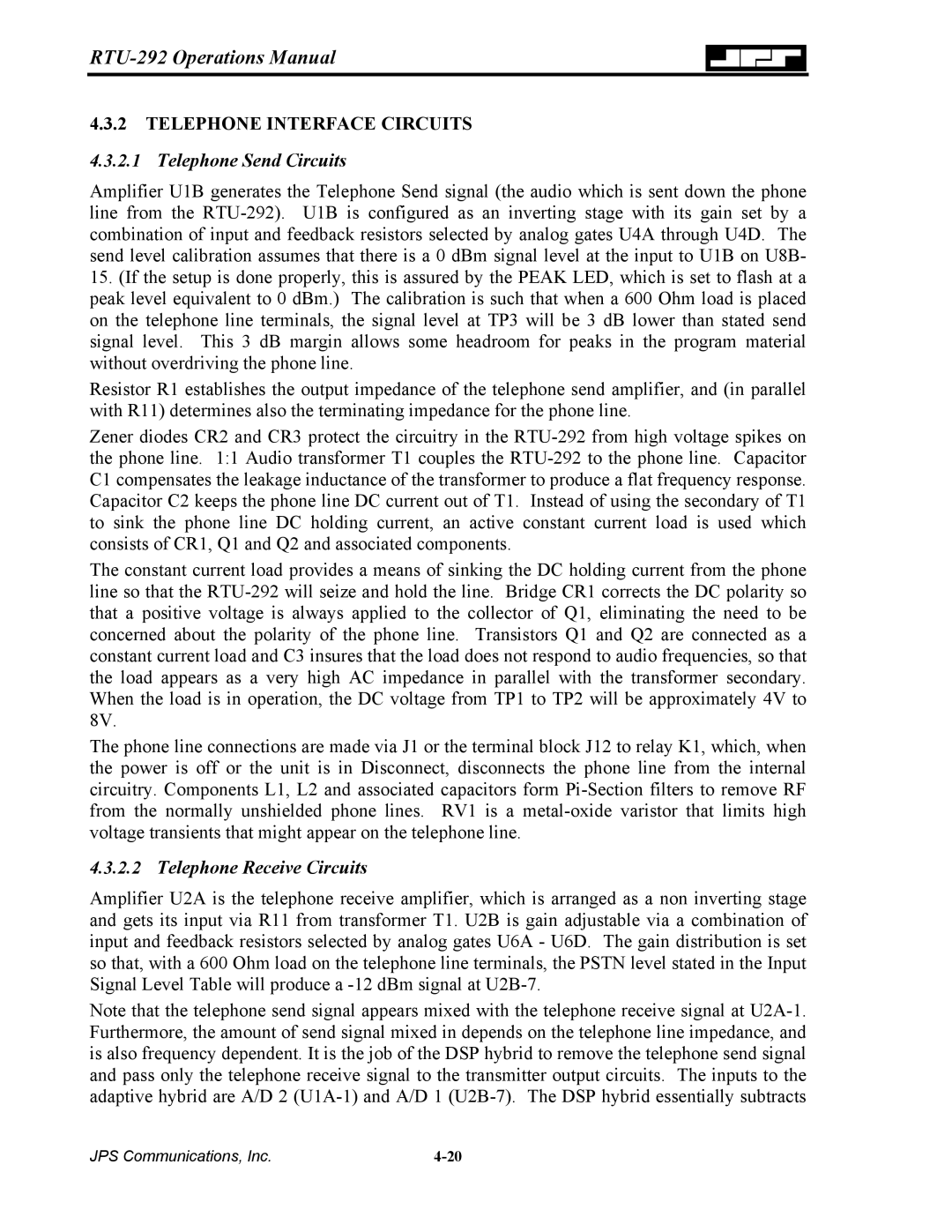4.3.2 TELEPHONE INTERFACE CIRCUITS
4.3.2.1 Telephone Send Circuits
Amplifier U1B generates the Telephone Send signal (the audio which is sent down the phone line from the RTU-292). U1B is configured as an inverting stage with its gain set by a combination of input and feedback resistors selected by analog gates U4A through U4D. The send level calibration assumes that there is a 0 dBm signal level at the input to U1B on U8B-
15.(If the setup is done properly, this is assured by the PEAK LED, which is set to flash at a peak level equivalent to 0 dBm.) The calibration is such that when a 600 Ohm load is placed on the telephone line terminals, the signal level at TP3 will be 3 dB lower than stated send signal level. This 3 dB margin allows some headroom for peaks in the program material without overdriving the phone line.
Resistor R1 establishes the output impedance of the telephone send amplifier, and (in parallel with R11) determines also the terminating impedance for the phone line.
Zener diodes CR2 and CR3 protect the circuitry in the RTU-292 from high voltage spikes on the phone line. 1:1 Audio transformer T1 couples the RTU-292 to the phone line. Capacitor C1 compensates the leakage inductance of the transformer to produce a flat frequency response. Capacitor C2 keeps the phone line DC current out of T1. Instead of using the secondary of T1 to sink the phone line DC holding current, an active constant current load is used which consists of CR1, Q1 and Q2 and associated components.
The constant current load provides a means of sinking the DC holding current from the phone line so that the RTU-292 will seize and hold the line. Bridge CR1 corrects the DC polarity so that a positive voltage is always applied to the collector of Q1, eliminating the need to be concerned about the polarity of the phone line. Transistors Q1 and Q2 are connected as a constant current load and C3 insures that the load does not respond to audio frequencies, so that the load appears as a very high AC impedance in parallel with the transformer secondary. When the load is in operation, the DC voltage from TP1 to TP2 will be approximately 4V to 8V.
The phone line connections are made via J1 or the terminal block J12 to relay K1, which, when the power is off or the unit is in Disconnect, disconnects the phone line from the internal circuitry. Components L1, L2 and associated capacitors form Pi-Section filters to remove RF from the normally unshielded phone lines. RV1 is a metal-oxide varistor that limits high voltage transients that might appear on the telephone line.
4.3.2.2 Telephone Receive Circuits
Amplifier U2A is the telephone receive amplifier, which is arranged as a non inverting stage and gets its input via R11 from transformer T1. U2B is gain adjustable via a combination of input and feedback resistors selected by analog gates U6A - U6D. The gain distribution is set so that, with a 600 Ohm load on the telephone line terminals, the PSTN level stated in the Input Signal Level Table will produce a -12 dBm signal at U2B-7.
Note that the telephone send signal appears mixed with the telephone receive signal at U2A-1. Furthermore, the amount of send signal mixed in depends on the telephone line impedance, and is also frequency dependent. It is the job of the DSP hybrid to remove the telephone send signal and pass only the telephone receive signal to the transmitter output circuits. The inputs to the adaptive hybrid are A/D 2 (U1A-1) and A/D 1 (U2B-7). The DSP hybrid essentially subtracts
